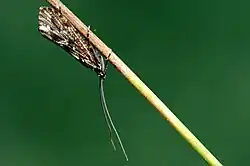Phryganeoidea
| Phryganeoidea | |
|---|---|

| |
| Phryganea bipunctata | |
| Scientific classification | |
| Kingdom: | Animalia |
| Phylum: | Arthropoda |
| Class: | Insecta |
| Order: | Trichoptera |
| Suborder: | Integripalpia |
| Infraorder: | Plenitentoria |
| Superfamily: | Leach, 1815 |
| Families | |
|
Phryganeidae | |
Phryganeoidea, the giant caddisfly superfamily, may be paraphyletic with Limnephiloidea.[1]
References
- ^ Wiggins, Glenn B.; Information, Canada Institute for Scientific and Technical; Museum, Royal Ontario (2004-01-01). Caddisflies: The Underwater Architects. University of Toronto Press. pp. 153–158. ISBN 978-0-8020-3714-5.
Body
Adult body length 14–25 mm (0.55–0.98 in); common species usually >20 mm (0.79 in).[1]
Identification
Adults large (body usually 20 mm (0.79 in) or more); forewings gray, brown, or yellowish-brown, sometimes with specks, patches, or other markings. Specific characters:[2]
- ocelli (simple eyes) present
- no wing hairs clubbed--character shared with some other families (1)
- maxillary palps 4-segmented in males, 5-segmented in females
- front tibia has 2 or more spurs, middle tibia has 4
%252C_Arnhem%252C_the_Netherlands.jpg)
- ^ "Family Phryganeidae - Giant Casemaker Caddisflies". bugguide.net. Retrieved 2024-06-03.
- ^ "Family Phryganeidae - Giant Casemaker Caddisflies". bugguide.net. Retrieved 2024-06-03.